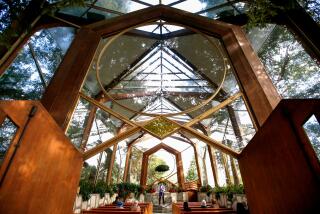A Mix of Ancient Teachings, Modern Lifestyles
- Share via
The priest of Ventura County’s only Buddhist church says it can be hard to explain his religion to an American.
“The Western concept of God makes it difficult to understand Buddha,” said the Rev. Kakei Nakagawa, who serves 350 families at the Oxnard Buddhist Church.
Founded 2,500 years ago by Gautama Siddhartha in India, Buddhism is even older than Christianity as a belief system, said Nakagawa, whose H Street church ministers to many of the Japanese Americans and Vietnamese Americans in Ventura County.
The word “Buddha” roughly translates to “enlightened one” from the original Sanskrit.
As they spread to other Asian nations such as China, Japan, Korea and Vietnam, the religion’s practices were shaped by the languages and cultural influences of each country.
The traditions of Buddhist Churches of America, with about a million practitioners, have been colored with Western touches such as Sunday services, Nakagawa said.
“There is not only one style in Buddhism,” he said. “The true Japanese Buddhist tradition, Shin Buddhism, is for the priest to visit the family’s home. That’s why every Buddhist family has its own shrine at home. Each morning, the family chants ‘sutras’ before their shrine. But in the U.S.A., we have church on Sunday morning.”
A typical Sunday service at Nakagawa’s church begins with the chanting of sutras, which are the writings of Buddha. The priest presents a short sermon in English, and the service ends with members approaching the shrine, or altar, and putting a pinch of incense into the burner.
“The shrine is to give a welcoming feeling,” Nakagawa said. “The candles, the bouquet of flowers, the incense--it smells good, it looks pretty and peaceful.”
Elsewhere, Buddhist places of worship are called temples, but U.S. Buddhists often call them churches.
No major religion can be reduced to a single-sentence explanation, but put simply, Buddhism holds that suffering is inherent in life, and one can escape it through mental and moral self-purification into “nirvana.”
Buddha was human, Nakagawa said, and Buddhism means to follow the teachings of Buddha. He added that although there is no equivalent to a Bible in Buddhism, “the best-selling book for the last 500 years in Japan is the Shinran.” Shin Buddhism is the branch of Buddhism that 95% of Japanese American Buddhists practice.
Buddhist Church member Arlene Keithley of Oxnard said that Shin Buddhists take a more scientific view of life than other branches.
“We are not superstitious,” Keithley said. “We don’t carry charms, such as a rabbit’s foot, to help influence the path of our life, as some sects do. One is responsible for one’s own actions.”
As in any religion, Buddhism has its own traditions.
On a recent Saturday morning at Oxnard’s Santa Clara Cemetery, Nakagawa and members of the family of Akiko Bergstrand of Port Hueneme gathered at her grave exactly one year after her death.
“It is a Buddhist custom that one year later, a memorial service is held,” said the woman’s husband, Harry Bergstrand, who attended the ceremony with the couple’s nine children. “Also three years later, five years, seven, then 13 years later.”
Several of Akiko Bergstrand’s relatives also came from Japan for the memorial service, including her oldest sister, Shigeko Shimizu.
With the family gathered around the grave, the priest lit incense at a portable lacquered altar while chanting hymns. In turn, each family member approached the altar and added a pinch of incense.
“This is to pay respect to Buddha,” Nakagawa said.
After the ceremony, a dove was taken from a cage and handed to Harry Bergstrand, who then released it into the air. Dozens of other doves were then released from nearby cages. They scattered in the sky, then swooped in a circle over the family before flying to the south.
“The doves symbolize the release of the spirit,” Bergstrand said. “It’s becoming common at the memorial service in Japan.”
More to Read
Sign up for Essential California
The most important California stories and recommendations in your inbox every morning.
You may occasionally receive promotional content from the Los Angeles Times.













